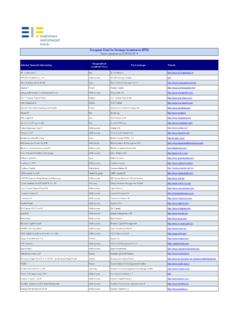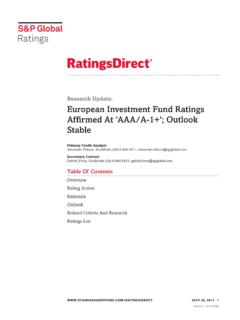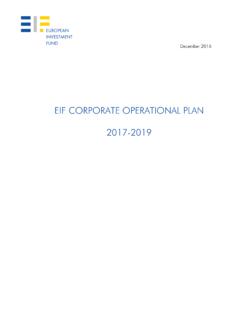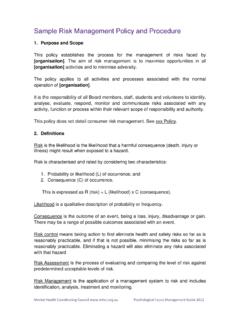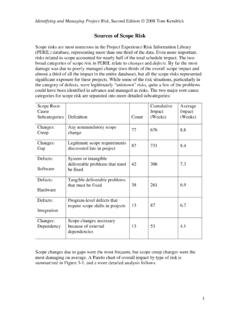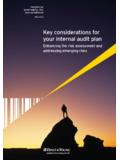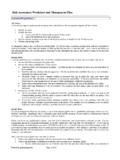Transcription of Operational Risk Management Charter - eif.org
1 Board of Directors Meeting 12/04/2010 Document approved Operational Risk Management Charter Table of contents A. I. Background ..3. II. Purpose and III. Definitions ..3. B. GOVERNANCE ..4. I. Key II. Responsibilities ..4. III. Procedural C. Operational RISK Management FRAMEWORK ..5. I. Operational Risk Management Tools ..5. Process Risk & Control Assessment ..5. Key Risk Indicators ..5. Operational Risk Scenario Analysis ..5. New Mandates, Products & Processes ..6. Operational Risk Awareness Program ..6. II. Relationship with Stakeholders ..6. EIB Audit D. CAPITAL E. Operational RISK TOLERANCE ..6. F. Charter ADMINISTRATION ..6. 2. A. INTRODUCTION. I. Background The Management of Operational risk is a key feature of sound risk Management practice in modern financial markets.
2 The recognition of Operational risk as a specific category next to market and credit risk by the Basel Committee on Banking Supervision in the Revised International Capital Framework demonstrates its growing importance. While the Management of Operational risk is the primary responsibility of each function or service responsible, the implementation of an integrated Operational Risk Management Framework shall be coordinated by a dedicated and independent team to achieve Operational excellence and to ensure alignment with best market practice. At EIF, the development and implementation of that framework forms part of the remit of Compliance &. Operational Risk (COR).
3 II. Purpose and Scope The Operational Risk Management Charter (the Charter ) applies to all EIF Staff, services, functions and external offices. The Charter codifies EIF's approach to identifying, measuring, managing, reporting and controlling Operational risk. It documents sound practices to help ensure that Operational risk is managed and measured in an effective and consistent manner across EIF and describes the key elements of the EIF Operational Risk Management Framework (the Framework ), including the main roles and responsibilities. The Charter also sets the basis of EIF's Operational risk culture. III. Definitions The definitions establish a common language for describing, understanding, reporting and classifying Operational Risk.
4 Core definitions are outlined in this section. Operational Risk is defined as the risk of loss or reputational damage resulting from inadequate or failed internal processes, people and systems or from external events. At EIF, this definition includes Legal Risk, Compliance Risk and Reputational Risk in line with standard market practice and in the light of the specific importance of reputational risk for EIF as a European International Financial Institution. Legal Risk arises from the potential that unenforceable contracts, lawsuits, or adverse judgments can disrupt or otherwise negatively affect the operations or conditions of the organisation. Compliance Risk is the risk of legal or regulatory sanctions, material financial loss or loss to reputation, the organisation may suffer as a result of its failure to comply with laws, regulations, rules, related self-regulatory organisation standards and codes of conduct applicable to its activities.
5 Reputational Risk is the risk resulting from adverse perception, whether true or not, of the image of the organisation on the part of EIF stakeholders, contractual counterparties, the public or supervisory authorities. Operational Risk Management encompasses the mechanisms, tools, policies, procedures and processes, including Management oversight, to identify, assess, monitor, report, and control Operational risk. An Operational Risk Event (ORE) is defined as a failure of internal processes, people or systems, or a result of external events. OREs may result in direct or indirect financial loss or, where this is not the case, in near-misses or may lead to an adverse effect on EIF's reputation, a breach of internal procedures, laws, regulations or good market practices.
6 3. Whereas Operational risk represents the potential occurrence of a risk, an ORE is the actual occurrence of a risk. OREs are categorized according to the following Operational Risk Event Types: Internal Fraud External Fraud Employment Practices and Workplace Safety Clients, Products and Business Practices Damage to Physical Assets Business Disruption and System Failures Execution, Delivery and Process Management B. GOVERNANCE. I. Key Principles At EIF, Management of Operational Risk is Everyone's Responsibility.. Guidance The EIF Board of Directors approves the Charter , including the governance aspects and the general framework. The Board of Directors also approves EIF's tolerance to Operational risk as described under section E of the Charter .
7 Ownership The Chief Executive (CE) and the Deputy Chief Executive (DCE) are responsible for ensuring that the appropriate Operational risk Management practices are in place and operating effectively. The CE and DCE retain the ultimate responsibility for the effective Management of Operational risk at EIF within the limits set by the Board of Directors. Independence In line with the principles set by the Basel Committee, COR is an independent Operational risk Management function that is responsible for the design and implementation of the Framework. Access to information COR has unrestricted access to any document or information deemed useful for the identification and assessment of Operational risk at EIF.
8 Oversight Internal Audit performs regular reviews of the Operational risk Management processes. These reviews include both the activities of the business units and of the independent Operational risk Management function. II. Responsibilities The CE and DCE. provide sufficient human and technical resources to support effective Management of Operational risk;. maintain an appropriate culture and set a tone conducive to effective and transparent Operational risk Management ;. sponsor the EIF Operational Risk Program. EIF function or service responsibles ensure that Operational risks (i) associated with their respective processes, people and systems, and (ii) from external events are identified and understood.
9 4. verify that internal controls and practices are in place, appropriate, operating effectively, and consistent with EIF Policies, legal and contractual obligations, and regulatory requirements;. timely contribute to the monitoring, reporting and escalation processes such that EIF. Senior Management is made aware of material changes to EIF's Operational risk profile. EIF Compliance & Operational Risk implements the Framework to support the Management of Operational risk;. develops Operational risk Management procedures in compliance with the Charter ;. operates and/or coordinates processes for the identification, assessment, reporting, monitoring and mitigation of Operational risk.
10 Provides advisory support to EIF services with regard to Operational risk Management and internal controls;. organises an Operational risk awareness and training program. III. Procedural framework The Operational risk procedures establish processes, roles and responsibilities for the implementation of the Framework in compliance with the Charter and good market practices. C. Operational RISK Management FRAMEWORK. The Framework is a set of integrated processes, tools and mitigation strategies that assist EIF. in managing and measuring Operational risk. The Framework supports EIF Senior Management in the alignment of business and risk Management goals and provides a foundation which enables a consistent approach to Operational risk across the organisation.


